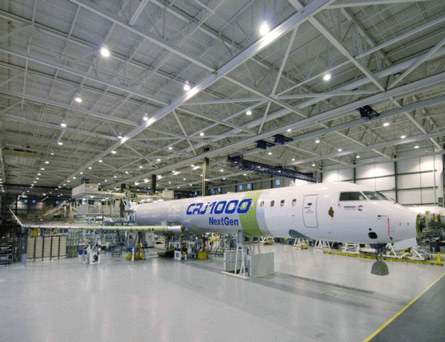Bombardier is working aggressively to avoid slashing production rates of its CRJ regional jets, but concedes "it will be a much more difficult year for the regional segment" overall if a number of sales campaigns for the aircraft fail to bear fruit.
The airframer has already announced a cut to its Q400 turboprop production, effective towards the end of the year, and is anxious to avoid repeating this on the CRJ line.
Economic uncertainty and market volatility are being blamed by the Canadian airframer for the dearth of orders in the regional segment.
Its CRJ backlog stands at 61 aircraft, or 15 months worth of production. The CRJ line for next year has "quite a few positions open", according to Bombardier.
"I'm concerned and we will have to make some decisions in the autumn on CRJ production rates if things don't improve," said Bombardier Aerospace president and chief operating officer Guy Hachey.
 |
|---|
© Bombardier |
The cut to Q400 production will give the manufacturer some breathing room as it tries to generate sales for a programme with a backlog of just 40 aircraft, or nine months production.
This "measured reduction" on the Q400 line means that the company's forecasted delivery of 90 regional aircraft for this year is under pressure and likely to be below that figure.
The picture could just as quickly change, however, "if we're able to land a few" of the eight to 10 campaigns worked on the regional aircraft side, Hachey said.
It is looking to throw more resources at the developing markets where it has had little success.
Hachey hopes the recent delivery of the first two Q400s to Indian carrier SpiceJet, part of a 15 aircraft order, will encourage other major Indian airlines to consider the type.
Bombardier's rival Embraer, meanwhile, "is doing great" with sales of its E-Jets, Richard Aboulafia, Teal Group vice-president of analysis said, "and ATR could not be doing better on the turboprop".
Aboulafia insists the problem is not with the regional market. "It is that all product development and sales resources have been diverted to the CSeries."
In its first half, Bombardier Aerospace revenue was up nearly 10% to $4.3 billion, but earnings before interest and taxes (EBIT) gained only 5% to $246 million.
Second-quarter revenue was up by 10% to $2.1 billion thanks to higher deliveries, but EBIT rose by less than 4% to $105 million.
And, the second quarter EBIT margin slipped by 0.2% owing partly to rising raw material costs.
Source: Flight International























